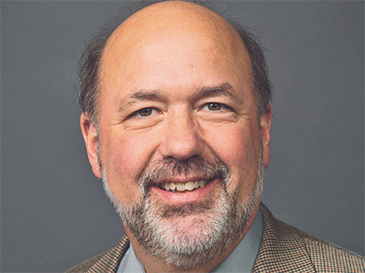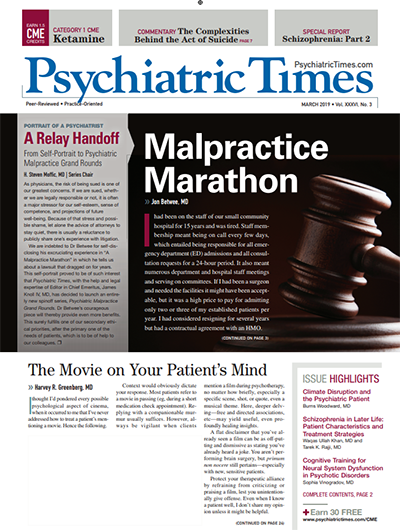Publication
Article
Psychiatric Times
Looking at the Past and Forward to the Future
Author(s):
We have come a long way in psychiatry, but we are still at the beginning of the story of understanding the human brain.
JOHN J. MILLER, MD

From the Editor
I am excited and appreciative to begin my new role as Editor in Chief of Psychiatric Times. First, I would like to thank the Psychiatric Times editorial staff, including Executive Editor Natalie Timoshin, Editor Heidi Anne Duerr, MPH, and Digital Managing Editor Laurie Martin, for inviting me to this position, and believing in my ability to serve in this role. Also, I would like to thank Allan Tasman, MD, and Michelle Riba, MD for their time, efforts, and thoughtfulness during their tenure as Editor in Chief and Deputy Editor during the past 4 years.
Since its inception in January 1985, when it was founded by John L. Schwartz, MD, Psychiatric Times quickly became the favorite and most-read psychiatric publication for the front-line clinician. Due to the wise and insightful guidance and stewardship of its first three Editors in Chief, John L. Schwartz, MD, Ronald W. Pies, MD, and James L. Knoll IV, MD, it has continued to be a monthly refreshing source of clinically relevant psychiatric information that remains timely, and at the same time enjoyable and accessible. As I become the fifth Editor in Chief in 34 years, I realize I have very big shoes to fill. I am up for the challenge. However, I encourage feedback and input from the editorial board as well as readers to assist us in the continuing growth of Psychiatric Times.
I find it cliché to say that we live in exciting times of new discovery that will transform our practice of psychiatry-as this can be said of any time in the past. Science is replete with statements of accomplishment and mastery, only to be upended as new discoveries force us to rewrite the old textbooks. The first version of the Periodic Table of the Elements was attributed in 1869 to Dimitri Mendeleev, which seemed to provide the explanation of physical reality. Although a major scientific accomplishment, science at that time was unaware of the existence of electrons and neutrons.
One of the foundations of modern physics is the electromagnetic spectrum of radiation. Before 1800, we were only aware of visible light-that small part of the spectrum you can see when light passes through a prism-ranging in color from red to purple. It was only in 1800 and 1801 that the spectrum was found to be broader, to include the infrared and ultraviolet. Finally, in 1895 the German physicist Wilhelm Röntgen “stumbled on X-rays while experimenting with Lenard tubes and Crookes tubes.” Subsequently, the entire electromagnetic spectrum was established, which ranges from gamma rays to radio waves. At the time of each of those monumental discoveries, scientists believed that they had finally figured out the nature of reality.
More pertinent to the present time is the continuing unravelling of the relationship between genes and disease. In 1953 James Watson and Francis Crick proposed that the structure of DNA was a double-helix, and a few years later correctly predicted the information flow from DNA to RNA to proteins. Biologists and chemists celebrated this new discovery as the answer to the mystery of life, and all that was left to do was fill in some of the details. Today, there are more questions than answers as to how the human genome of 3 billion base pairs produces a living, breathing, and conscious person. Many mysteries wait to be solved, including the answer to why only 2% of the human genome codes for proteins-the rest codes for small RNAs whose roles we are just beginning to glimpse. Layer on to this the evolving field of epigenetics, and your mind will truly be blown (more on this in future editorials).
For us in psychiatry, it has been a mere 30 years since we have redefined the human brain from being a “black box” to a structure of circuits containing 80 billion neurons and approximately 100 trillion synapses-fondly named the connectome-which makes each person beautifully unique. So yes, we have come a long way in psychiatry, but we are still at the beginning of the story of understanding the human brain. Trained initially as a biochemist, I have reveled in the significant advances in understanding brain structure and function, and in our ever-evolving armamentarium of psychiatric treatments-medications, evidence-based psychotherapies, neuromodulation, vocational support, psychoeducation, and preventive health. Equally important are the clear brain and body benefits of a good night’s sleep, exercise, healthy social relationships, good nutrition, stress reduction, laughter, lifelong learning, employment, and feeling connected to something greater than oneself.
However, as history has taught us, the discoveries of today will become the fossils of tomorrow. I do not say this to be bleak, but rather to remind us that our creative minds must always be open to new treatments that result from a new understanding. Each issue of Psychiatric Times serves as a bookmark in time to declare where we are and some day to reflect back on where we have been. Finally, we must continue to advocate for our patients, support our colleagues, erase stigma, and educate politicians/insurers/policy makers about the primal necessity of global mental health.







